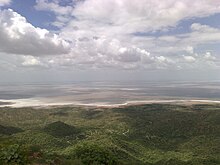Rann from Kachchh

The Rann of Kachchh ( Gujarati કચ્છનું રણ , Hindi कच्छ का रण , English Rann of Kutch ) is a temporarily flooded salt marsh on the southern section of the border between India and Pakistan . It covers around 28,000 km², including the little Rann of Kachchh to the south-west, and is largely in the area of the Kachchh district in the western Indian state of Gujarat , south of the Thar desert . Only a small part belongs to the Pakistani province of Sindh . The word "Rann" is borrowed from Hindi and means salt marsh .
Originally the Rann of Kachchh was a bay in the shallow Arabian Sea . This was cut off from the sea by uplifting the seabed and a huge salt lake was created that was still navigable in ancient times . Over time, the lake silted up into a salt marsh. This is regularly flooded by up to 50 centimeters during the short rainy season from July to September. Only a few sandy, salt-free areas protrude two to three meters above the water surface. At this time, several rivers also flow into the salt lake. In the dry season, only the Luni flows to the Rann von Kachchh in order to seep away there.
Flora and fauna
Only a few plants thrive in the dry, hot, hostile environment, especially grasses and thorn bushes. Trees are only found sporadically in the salt-free areas that are not flooded.
Only a few larger animal species have adapted to the inhospitable conditions of the salt marsh. For the Khur ( Equus hemionus khur ), also known as Ghorkhar or Indian half ass , the Rann of Kachchh is one of the last retreats in India. There are also about 50 other mammal species, including the Indian gazelle ( Gazella bennettii ), the Nilgau antelope ( Boselaphus tragocamelus ), the stag goat antelope ( Antelope cervicapra ), the wolf ( Canis lupus ), the striped hyena ( Hyaena hyaena ), the Indian steppe cat ( Felis silvestris ornata ) and the caracal or desert lynx ( Caracal caracal ). Around 200 bird species are native to the Rann von Kachchh, and many migratory birds from Siberia spend the winter there . To protect the animal species that occur, some of which are threatened, large parts of the area have been placed under nature protection and form the Dhrangadhra game reserve .
Border disputes
In the past, the largely uninhabitable salt marsh was the subject of a territorial dispute between the warring neighboring states of India and Pakistan . Pakistan insisted on drawing the border in the middle of the lake that existed during the rainy season, roughly along the 24th parallel. In the case of border waters, international law usually defines the middle of the water as the border line. India, on the other hand, insisted on the historical border of the former princely state of Kachchh . In 1965, in the run-up to the Second Indo-Pakistani War , fighting over the Rann von Kachchh broke out in which at least 450 soldiers were killed. After negotiations brokered by British Prime Minister Harold Wilson , the two countries agreed on February 19, 1968 to partition the area. 10 percent were allocated to Pakistan, 90 percent remained with India. Shortly after the so-called Kargil War between India and Pakistan, which took place almost exclusively in the high mountains of Kashmir, a Breguet Atlantic of the Pakistani naval forces was shot down on August 10, 1999 , which had probably violated Indian airspace in the area of the Rann von Kachchh revived the tension. The demarcation in the area of Sir Creeks is further controversial.
Web links
- My Name Is Salt , Indian-Swiss documentary by Farida Pacha, Trigon-Film (2013)
literature
- D. Konrad: Rann of Kutch Arbitration. In: Encyclopedia of Public International Law. Volume 2, 1981, p. 240.
- J. Gillis Weather: The Rann of Kutch Arbitration. In: American Journal of International Law. Volume 65, 1971, ISSN 0002-9300 , p. 346.
- Hari Ram Gupta: The Kutch Affair. UC Kapur, Delhi 1969.
- Saeed Ahmad: The Indo-Pak clash in the Rann of Kutch. Army Education Press, Rawalpindi 1973.
- M. S Deora, R. Grover: Rann of Kutch and after. Anmol Publications, New Delhi 1998.
- Herbert Wilhelmy: Indus Delta and Rann of Kutch. In: Geography - Archive for Scientific Geography. Volume 22, No. 3, autumn 1968, ISSN 0014-0015 , pp. 177-191 ( PDF; 3.4 MB ).
Individual evidence
- ↑ a b REPORTS OF INTERNATIONAL ARBITRAL AWARDS. (PDF) United Nations, February 19, 1968, accessed August 14, 2016 .
- ↑ India downs Pakistani plan. BBC News, August 10, 1999, accessed August 14, 2016 .
- ↑ Pakistani plan 'may have crossed border'. BBC News, August 13, 1999, accessed August 14, 2016 .
- ^ The disputed Sir Creek. BBC News, August 10, 1999, accessed August 14, 2016 .
Coordinates: 24 ° 4 ′ 17.6 ″ N , 70 ° 40 ′ 20.3 ″ E


